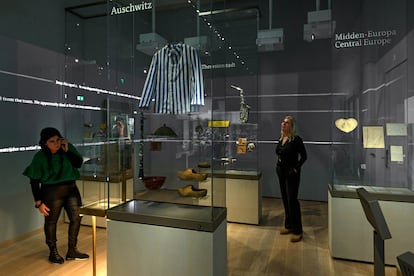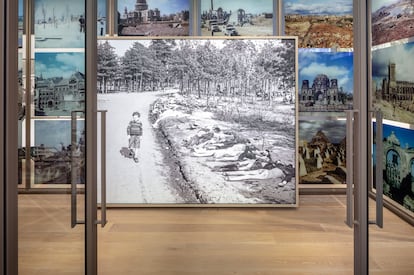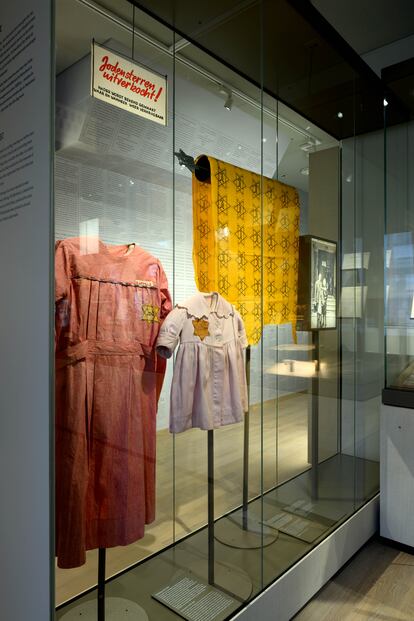‘Now that you know, never forget’: The Netherlands confronts its collaboration with the Nazis in the Holocaust
For the first time in the Netherlands, a new museum in Amsterdam comprehensively covers the deportation of a community that lost 102,000 members, the largest number in Western Europe


The National Holocaust Museum in Amsterdam, which opened to the public last Monday, commemorates the persecution of Dutch Jews. It is a tragedy that has taken the Netherlands decades to confront despite the fact that the Nazis murdered around 102,000 people there, according to the Anne Frank Foundation. It was the largest number of Jews killed from any one country in Western Europe.
The walls of one of the rooms at the museum, located in the same neighborhood where the Jews lived before the Second World War, are covered with the texts of the discriminatory laws enacted during the occupation. Assisted by Dutch officials, the Nazi regime methodically dehumanized Jews to death.
Almost 80 years have passed since the country’s liberation by Allied troops, and the museum’s opening is long overdue, as many of the survivors are disappearing due to advanced age. Several institutions portray parts of the history of the Jews in World War II, including the Anne Frank House, but none fully documents the Holocaust on a national scale.
“For us, it is crucial to tell it in its context: before the war, during the occupation, and how the population faced this painful chapter after 1945,” says Annemiek Gringold, one of the museum’s curators. According to her, the local situation was different from what happened in Central and Eastern Europe. “The sequence that endures is the one that goes from the ghetto to the concentration camp and to death,” she says. In the Netherlands, on the other hand, it was carried out through law.
From the German invasion of the Netherlands in May 1940, the Nazis were dismantling the legal order. “By imposing new rules that excluded Jews from society, they were stripped of their property and kicked out of work and school. All of this was applied by Dutch officials,” says the expert. Written on the walls of one of the rooms, a myriad of laws show that the Nazis saw non-Jewish Dutch “as part of the dream of greater Germany.” Because of this, the occupation was based on a civilian administrative structure, rather than a military one, as in Belgium or France.
“In the Netherlands there were hardly any German soldiers on the streets. It was about excluding Jews from society, but accepting the rest of the population,” says Gringold. She admits that it was “very effective.” A sign reads that some 25,000 Dutch volunteers joined the German Waffen-SS (protection squads) “in search of adventure or motivated by Nazi ideals.”

The museum has taken advantage of and renovated the facilities of a former Protestant teacher training center, whose principal, Johan van Hulst, cooperated with Henriette Pimentel, the principal of an adjacent kindergarten in 1943. The latter no longer exists, but the centers’ backyards were connected. By passing them through the yard, the educators managed to save 600 Jewish children who were awaiting deportation along with their parents. The adults were grouped in an open theater in front, and their children were taken out of school camouflaged in bags, baskets, or suitcases, taking advantage of passing trams — which continue to run in both directions today — and with the help of the resistance.
In one of the hallways on the ground floor, footprints are projected on the floor to remind us that Jewish children were smuggled out from there. Their fate was to disguise themselves as Aryans in families in the countryside or to hide in other places.
Emanuel Flip Delmonte, 80, was one of the lucky ones. He was one year old when he was secretly evacuated from daycare. His entire family was murdered and, as he walked through the rooms on Monday, he asked “that the dead be remembered by the living.” He has donated a photo of himself taken after the war. Last Sunday, King Willem-Alexander of the Netherlands inaugurated the museum amid a citizen protest over the presence of Isaac Herzog, president of Israel, while the war in Gaza is still ongoing.

To try to restore their personhood to the victims, more than 2,500 personal objects have been collected. Sought among all social strata to reflect the diversity of Dutch Jews, they have great emotional value. Some pieces come from those who lived in the former colonies of Suriname and Indonesia.
There are also some faded passport-sized photos of an unknown family. Without names or surnames, they plead in a few hurriedly written lines: “Don’t forget us.” Next to one of the striped shirts of the uniform imposed in the concentration camps, you can also see the silk wedding dress of Leny Zondervan, whose parents perished in Auschwitz. In a display case there are photos of her brothers Raphael (six years old) and Franklin Altmann (four)— murdered in the same place — along with the dolls that their grandfather made for them. They are accompanied by Nico Kroese’s table football, murdered at the age of 11 in Sobibor; a length of cloth full of yellow stars with the word “Jew,” which had to be worn on their clothing; a nursery crib; and the voluminous first tome of the Auschwitz death register, dated 1942.
In one of the rooms they have installed mural-sized photos that take your breath away. Like that of Sieg Maandag, a seven-year-old boy who is walking past a row of corpses lying on the side of the road in the German concentration camp of Bergen-Belsen in 1945, liberated in April by British troops. The horror contrasts starkly with the bright day and the trees full of leaves.
Only 25% of the Dutch Jewish community survived, and upon their return from the extermination camps and their hiding places (of around 28,000 refugees, around 16,000 survived) they were hardly paid any attention. According to the curator, “the country was more antisemitic than before the war due to propaganda, and was not prepared to listen to the Jewish victims.”
Within two years after the Nazi invasion, the application of German laws was such that Berlin declared the Netherlands “free of Jews” in 1944. Official recognition of the suffering Jews in the Netherlands during the war dates back to the late 1990s and always within the framework of commemorative ceremonies. Before the war, there were 77,000 citizens of Jewish descent in Amsterdam, according to the Anne Frank Foundation.

The Holocaust Museum has taken two decades to gather public and private funds to be able to establish itself and, among them, €4 million ($4.3 million) from the German Government and €5.3 million ($5.7 million) from the Dutch Executive stand out. On a sign you can read that the new museum is also a way of warning that, under certain social or political conditions, ordinary people are capable of committing terrible crimes: “The vital message is that indifference should never be shown in the face of injustice.” Johan Van Hulst died in 2018, at the age of 107, and always remembered the little ones he could not rescue. Henriette Pimentel died in Auschwitz, in 1943, at the age of 67. Another phrase, projected on the wall, instructs visitors: “Now that you know, never forget.”
Sign up for our weekly newsletter to get more English-language news coverage from EL PAÍS USA Edition
Tu suscripción se está usando en otro dispositivo
¿Quieres añadir otro usuario a tu suscripción?
Si continúas leyendo en este dispositivo, no se podrá leer en el otro.
FlechaTu suscripción se está usando en otro dispositivo y solo puedes acceder a EL PAÍS desde un dispositivo a la vez.
Si quieres compartir tu cuenta, cambia tu suscripción a la modalidad Premium, así podrás añadir otro usuario. Cada uno accederá con su propia cuenta de email, lo que os permitirá personalizar vuestra experiencia en EL PAÍS.
¿Tienes una suscripción de empresa? Accede aquí para contratar más cuentas.
En el caso de no saber quién está usando tu cuenta, te recomendamos cambiar tu contraseña aquí.
Si decides continuar compartiendo tu cuenta, este mensaje se mostrará en tu dispositivo y en el de la otra persona que está usando tu cuenta de forma indefinida, afectando a tu experiencia de lectura. Puedes consultar aquí los términos y condiciones de la suscripción digital.
